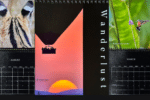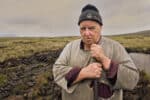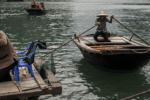
Always wanted to have one of these published:-)
Actually, I’m pretty happy with the picture, and my editor at the Geographic, Bill Douthitt, made a good pick here. The jazzy looking thing in the photo is NASA’s Hyperwall-2, a conglomeration of 128 hi def screens all linked together via a main frame computer the size of Arizona and spinning out coordinated images of the galaxy. The huge telescopes at play now generate tons of information every night on ever deeper areas of space, and this device is one way scientists can actually visualize the info these puppies are generating. I was like, hey, I got a DVD of Death Race, whaddaya think? Wanna pop it on? The scientists frowned at me.
I’ve always believed that the art and craft of photography is a diverse collection of styles and substances comfortably living together and jostling each other in creative fashion under one big tent called visual storytelling. You can shoot phojo on the streets, fashion in the studio, landscape in the wild, you name it. All of it is valid, all of it has merit. Being a generalist myself, I’ve always embraced that notion of diverse approaches, even within the context of a single story. Most of the stories I’ve shot for the Geographic in the 25 years I’ve worked for them have been either problem children, or grab bags of diverse elements that needed sorting out. In other words, I’ve had stories in the mag that over a series of pages encompassed portraiture, straight up photojournalism, production work, and concept photography. A big, rambunctious hodgepodge of stuff, all of it heading in the same direction, albeit down different paths.
The question at the end of the day that needs to be asked is: Does it serve the reader? That’s the bottom line. The page stops there. We are a conduit. It’s our job to communicate in a powerful, effective and interpretive way the visceral, flesh and blood experience we are having in the field with the camera in our hands onto ink and paper, and see it get shipped halfway round the world and hope that someone opens those pages and goes, “Holy shit!”
That’s hard to do. Sometimes, on these stories, you have to wait out there with the patience of Job, and let the story and the pictures come to you. Other times, you have to dig for it like deep core driller. Other times, you have to think it through, and play out the story in your head, then go out there and create pictures that give that it a beginning, and end, and a meaning. All different approaches, all valid. (Tom Kennedy, the DOP for a number of the stories I shot at the yellow magazine, used to say there was a tipping point in every assignment when the photographer, after having the story just generally kick their butt for a while, steps forward and gains control of it. That eureka moment can come from a shot frame that turns the key in the photog’s head and heart, or from a signature personality encountered during the coverage, or even a stray phrase or piece of conversation. After that, the shooter knows what is needed, and where the pictures should go, even if that destination is surprising and unanticipated.)
The pic up top was just me by my lonesome, no assistant, and a couple of bags of stands and small flashes. It was a great day. How often do you get into a room with a device like this and have people say to you, okay, it’s pretty much yours’ for the day? (The crew of folks running this device were terrific.) Worked hard, and ran through a bunch of different lighting scenarios during the course of things, some of which worked, and others that were perfectly ridiculous.
The glow behind the array comes from four SB units, gelled a deep theatrical blue and pounding into the back wall. That surface serves as a giant fill board to wash the light off, hence the glow that surrounds all the monitors, and helps define them. (Don’t light it, light around it.) That was the basic building block of the shoot–the background light, not the foreground light. Drew took every frame I shot that day and squished them into a quickie movie you see below. Things got a little strange there, in the dark, with me using myself as a polaroid subject, but ya gotta have some fun.
I also tried some stuff with a couple of lights on the scientists at the work station driving the imagery on the screens.The keys for the people in foreground were another set of SB units, gridded and gelled warm, just establishing someplace for the person out there in all the foreground blackness to live. To give form and shape, basically.



I pretty much knew the zoom wouldn’t fly back at the ranch, but ya never know, so I gave it a try. On location, shoot it. Don’t think for the editor. Don’t foreclose a possibility. You will never be there again.
At the end of the day, the published double truck was a pointing picture, that old no no of press photography. But it worked okay. Once again, we are in a business without rules.
I tell ya, it was easier than this shot.

I showed this one before on the blog, and it is in the current American Photo. This is a whole mess of big flash, three assistants, two truckloads of gear, and a very nervous photog atop a 175′ boom crane.

Not nervous because of the height, just nervous I wouldn’t get the damn picture after all that trouble. The crane had a 25 mph wind tolerance, which you can easily exceed at 11,000 plus feet on Mt. Graham. That bucket was waving around pretty good, but thankfully, it remained calm enough that they didn’t pull me outta the sky.
So both of these efforts ran in the story, the big effort atop the mountain, and the one conjured by me with few small flashes, dinking around in dark room for a day. Radically different methods and scale of approach. But they both helped tell the story. And I guess that’s the point…..more tk….













As always a combination of the great and small all wrapped up in an amazing shoot from an awesome guy. Thanks for letting us in on your insight.
Great shot(s)!
At the end of the day, how many shots did you hand over to the editor to choose from?
Haha my place would pick a ‘pointy’ pic every time. They’d prefer the ‘thumbs up’ shots if I’d shoot them!
Nice set of pics, thanks for the walkthrough.
Great stuff Joe…loved Drew’s video–and the choice of Soulive was inspired…
So Cool!
What amazing, amazing photography. Only McNally!
Two things.
1. There are 130 screens (15×8)
2. I need a life.
T
Pretty awesome pics there Joe!!…Nice work with Nat Geo.
Hey,could you draw us one of your “Numnuts” comic strips (hehe) and illustrate the lighting behind the screen,I didn’t quite get what you said.
Great work again!!
Trev
Great blog Joe…You never cease to amaze me, been following you for a while now and you really are an inspiration to my generation of photographers (the just 30 group). I have practiced your suggestions in the field with my photography and it pays off every time! Thank you for the insight you share with all of us and…I think like you, Death Race would have been awesome on those screens…or maybe just a big preview of “I’ll light you for it”…take care and keep us coming back for more ~ Brian Smith – S&R Photography – Jacksonville
Thank you for this post!
Wow Joe, that is awesome. I really love seeing your “backstage” or “making-of” shots/movie.
I must have been pretty chilly out there on that crane. Nevertheless, the result is top-quality as always.
Keep up blogging, we’re enjoying it and learning a lot from it as well.
Cheers from Quebec, Canada
Alex Campagna
No freakin’ way I’m getting in that bucket!
You really are Numnuts!
Hey Ed,
Nat Geo gets every single frame out of the camera. Literally, all I do is rename the files and take out any blank frames, or anything completely out of focus..which of course never happens 😉 Then we send off the entire take of raw files, completely untouched.
-Drew
Very dynamic image of the big screen. The keystoning helps give it punch, I think.
LOL! My editor always asks me why I “didnt get one of them pointing” gah! if he saw this he’d feel all vindicated and stuff.
Love that zoom shot.
One of my favorite shoots and stories of yours
Totally awesome! I have to say I have learned so much from your blog. It really is amazing what all you go through to get “the picture” – I could never have imagined what it takes. Thanks for all your sharing and insight!!
Damn, your good
Bravo!
If God has a control room for the universe, it looks like this.
GZ
OK…I want to know where I can get a copy of all these photography rules. I know I must be breaking some of them, cause I the pointy picture was working for me….
JoeH
In the first picture (with all the computer displays), how did you remote the SB units? Using a SB900 as master? or the SU-800 on a long long wire?
“Holy shit” indeed.
Joe/Drew,
What did you guys use to trigger those blue gelled SB’s?
Thanks!
As always, bravo Joe, your work is always inspiring! I agree with a few others, a Numnuts diagram on the lighting would be great!
WOW! As always, just wow, Joe!
Amazing lighting as usual. You’re the Man Joe
Great pictures Joe !
Love the vision behind it too :: thinking about the crane than doing it, that is just pure genius !
You’re a huge inspiration Joe! Keep up the good work 🙂
Great images Joe and a sweet track for the vid.
Are you doing Dobbs Ferry next year ??
Joe-This photo is epic. And as usual the blog is extremely well written.
Again, one of your best posts ever. You give us insight into the techical aspects, but man…. some of your quotes in here just sing.
“I’ve always believed that the art and craft of photography is a diverse collection of styles and substances comfortably living together and jostling each other in creative fashion under one big tent called visual storytelling.”
Awesome.
“On location, shoot it. Don’t think for the editor. Don’t foreclose a possibility. You will never be there again.”
Absolutely.
Just killer McNally stuff.
The Nat`Geographic Joe! Awesome, I`ve seen those pictures in the magazine didnt`know…Just awesome!
Loved the “disco scene” at about 1 minute into the slideshow with the two dancers. I’m sure that’s what inspired Joe to have the model do the “John Travolta” type point in the selected shot!
gasp.. you kill me Joe! can’t wait to finally meet you in person in Kuala Lumpur on 1 Feb 2010.
Again you are just amazing …
would love to see you bring out a book with how you came up with the idea a before and after pic and the sketch of how you set up your flash with e.g. gels, power etc i reckon it will be a big seller just remember who came up with the idea 🙂
That boom crane makes me feel physically sick…. how can you do that? Seriously?
Hi there,
There are 2 things that seem to put stress on a person probably more than anything else Money and trying to make money. It’s comforting to know that one of the best online money making programs for beginners were, ready for this, written by someone that started out from the bottom themselves with the exact same problems.